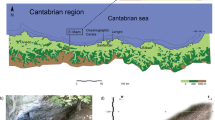Abstract
Amusium laurenti is a functional hermaphroditewith well differentiated male and female gonadalareas. The gonadal index varies throughout the yearwith maximum values occurring in January, March andJuly, and minimum ones in August and September. Partial spawning (with respect to the individual andthe population) occurred from January to February andMarch to May. The major spawning event coincided withthe end of the period during which bottom watertemperature increased to temperatures above 26°C(July–August). Subsequently temperature decreased to22°C, with a period of gonadal restoration andincreasing gonadal index. Histological analysis ofthe gonads correlated with the gonadal index.
Similar content being viewed by others
References
Abbott, T. (1974) American Seashells, Van Nostrand Reinhold Company, New York, 663 pp.
Bourne, N. (1964) Scallops and the offshore Fishery of the Maritimes. Fisheries Research Board of Canada Bulletin 145, 1–60.
Brea, J. (1986) Variaciones energéticas estacionales en la composición bioquímica de Pecten ziczac (Lineus, 1753) en relación con el metabolismo energético, reproducción y crecimiento. Lic. Biol. Tesis. Escuela de Ciencias, Universidad de Oriente, Cumaná, Venezuela, 75 pp.
Christiansen, H.E. and Olivier, S.R. (1971) Sobre el hermafroditismo de Chlamys tehuelcha d'Orb., 1846 (Pelecypoda, Philibranchia). Anales de la Sociedad Científica Argentina 191, 115–127.
Coe, W.R. (1943) Development of the primary gonads and differentiation of sexuality in Teredo navalis and other pelecypod molluscs. Biological Bulletin 84(2), 178–186.
Coe,W.R. (1945) Development of the reproductive system and variation in sexuality in Pecten and other pelecypod molluscs. Transactions Connecticut Academy of Arts and Sciences 36, 673–700.
Díaz, J.M. and Puyana, M. (1994) Moluscos del Caribe Colombiano, COLCIENCIA y Fundación Natura Colombia, Santa Fe de Bogotá, Colombia, pp. 291+LXXIV.
Heald, D.I. and Caputi, N. (1981) Some aspects of growth, recruitment and reproduction in the southern saucer scallop, Amusium balloti (Bernardi, 1861) in Shark Bay, Western Australia. Fishery Research Western Australia 25, 1–33.
Llana, Ma E.G. and Aprieto, V.L. (1980) Reproductive Biology of the Asian Moon Scallop Amusium pleuronectes. Fishery Research Journal of Philippines 5(2), 1–10.
Mason, J. (1958) The breeding of the scallop, Pecten maximus (L.) in Manx Waters. Journal Marine Biological Association UK 37, 653–671.
Naidu, K.S. (1970) Reproduction and breeding cycle of the giant scallop Placopecten magallanicus (Gmelin) in Port au Port Bay, Newfoundland. Canadian Journal of Zoology 48, 1003–1012.
Novoa, D., Mendoza, J., Marcano, L. and Cárdenas, J.J. (1998) Atlas pesquero marítimo de Venezuela. MAC-SARPA-Congepesca. Caracas, Venezuela, 197 pp.
Penchaszadeh, P. and Salaya, J.J. (1983) Reproduction and Gonadal changes in Laevicardium laevigatum (Mollusca: Bivalvia: Cardidae) of Golfo Triste, Venezuela. The Veliger 25(4), 343–346.
Posgay, J.A. (1950) Investigation of the sea scallop, Pecten grandis. In Third Report on Investigations of Methods of Improving the Shellfish Resources of Massachusetts, Mass. Department of Natural Resources, Division of Marine Fisheries, pp. 24–30.
Reddiah, K. (1962) The sexuality and spawning of Manx Pectinids. Journal of the Marine Biological Association, U.K. 42, 683–704.
Salaya, J.J. and Penchaszadeh, P.E. (1979) Pesquería de la vieira, Pecten papyraceus (Mollusca-Bivalvia), en Venezuela. In: J.B. Higman (ed.), Proceeding of the Thirty-First Annual Gulf and Caribbean Fisheries Institute. Miami, USA, pp. 105–126.
Salaya, J. J. and Penchaszadeh, P.E. (1980) Contribución al conocimiento de la reproducción de la vieira Pecten papyraceus en Golfo Triste, Venezuela. In Actas II. Simposio de la Asociación Latinoamericana de Acuicultura, México, pp. 846–870.
Vélez, A., Alifa, E. and L. Freites (1993) Inducción de la reproducción en la vieira Euvola (Pecten) ziczac (Mollusca: Bivalvia). Maduración y desove. Caribbean Journal of Science 29, 209–213.
Waller, T.R. (1991) Evolutionary relationships among commercial scallops (Mollusca: Bivalvia: Pectinidae). In S. Shumway (ed.), Scallops: Biology, Ecology and Aquaculture, Elsevier, New York, pp. 1–72.
Yamamoto, G. (1953) Ecology of the scallop Pecten yessoensis Jay. Scientific Reports of Tôhoku University, Series 4, 20, II-32.
Yonge, C.M. (1951) Studies on the pacific coast Mollusks. III. Observations on Hinnites multirugosus (Gale). University of California Publication, Zoology 55(8), 409–420.
Author information
Authors and Affiliations
Rights and permissions
About this article
Cite this article
Penchaszadeh, P.E., Paredes, C. & Salaya, J.J. Reproductive cycle of the south American scallop Amusium laurenti (Gmelin, 1791) (Bivalvia, Pectinidae). Aquaculture International 8, 227–235 (2000). https://doi.org/10.1023/A:1009239831230
Issue Date:
DOI: https://doi.org/10.1023/A:1009239831230




